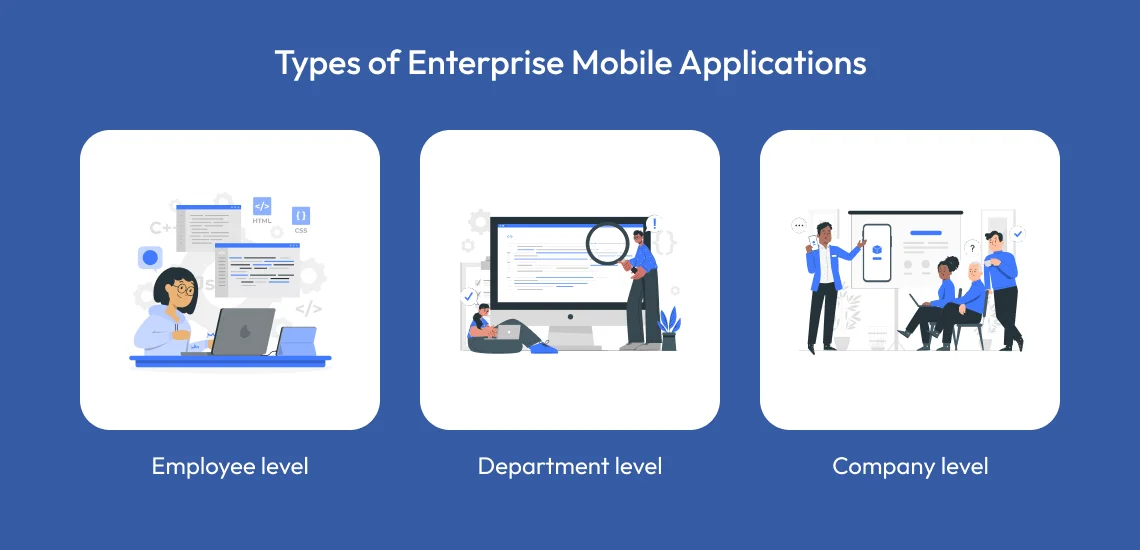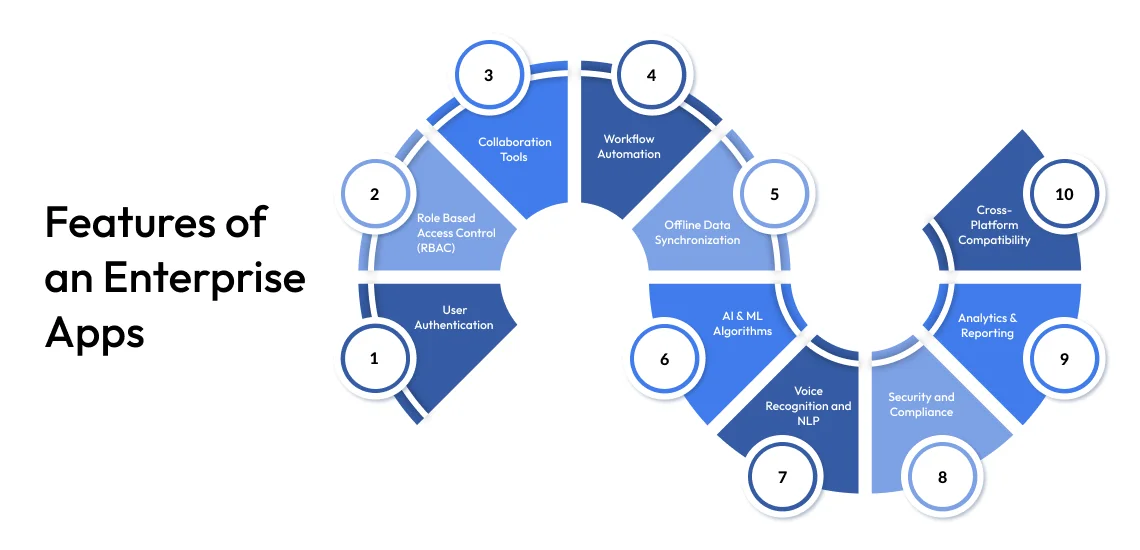Enterprise Mobile App Development: Best Practices, Process and Strategies
- Mobile
- May 10, 2024
Enterprise mobile app development enables companies to enhance productivity, encourage collaboration, and deliver superior customer experiences. However, the process is quite lengthy and tricky to execute, even for experienced developers. To help you comprehend it, we have developed this end-to-end guide that covers important aspects and takes you through each step.
With a myriad of technologies and methodologies, enterprise mobile apps have gained a significant position in various business domains and industries. Organizations have been using mobile apps to enhance customer engagement, improve accessibility, and streamline operations.
The app equips businesses with management powers, helps navigate the digital landscape, boosts productivity, and offers personalized experiences to customers like never before.
- But what goes into the enterprise mobile app development process?
- What are the key steps?
- How do businesses ensure their apps are secure, scalable, and user-friendly?
- What technologies and strategies help in enterprise mobile application development?
Hold on to your curiosity because, in this blog, we’ll explore the answers to these questions and more. From initial ideation and planning to deployment and beyond, the blog will provide the required knowledge needed to understand the enterprise mobile application development process.
What is an Enterprise Mobile Application Development?
An enterprise mobile application is a software app designed for mobile devices that has been specifically developed to execute in-house operations of an organization or business environment, addressing specific requirements and resolving issues.
Opposite to consumer-oriented mobile apps, these apps are customized to integrate seamlessly with existing systems, workflows, and business processes, aiming to enhance productivity, streamline operations, and facilitate communication and collaboration.
Types of Enterprise Mobile Application Development
Different types of enterprise applications cater to varying business and organizational requirements. These apps are classified into three main categories based on their purpose and target audience. Here are some common types of these apps:

Employee Level Enterprise Mobile Applications
These apps help track and improve employee productivity and efficiency. They offer reliable tools for time tracking, project management, collaboration, and communication. These applications are often tailored to specific roles or departments to streamline particular tasks.
Some of its examples are the following:
- Employee Communication Apps
- Task management Apps
- Time Tracking Apps
- Attendance Marking Apps
- Employee Training and Learning Apps
- Performance Management Apps
- Employee Wellness Apps
- Remote Work Management Apps
- Shift Scheduling Apps
Departmental Level Enterprise Mobile Applications
These are specialized mobile app solutions designed to meet the distinct needs and workflows of specific departments within an organization. Focused functionality is their main highlight as they are tailored to execute the tasks and responsibilities of each department, ranging from finance and human resources to marketing, operations, and beyond. They integrate with enterprise-wide systems to ensure seamless data exchange and provide insights to help with decision-making.
Below mentioned mobile apps are some of its prime examples:
- Finance and Accounting Applications
- Human Resources Management System (HRMS)
- Manufacturing Execution System
- Research & Development System
- Marketing Automation Platforms
- Project Management Software
- Demand Forecasting Apps
- Inventory Management Applications
- Communication Apps
Company Level Enterprise Mobile Applications
With features for customization, scalability, and integration into external systems, these apps serve as the backbone of organizational operations. They support enterprise digital transformation and enable seamless coordination and allow data exchange across departments, streamlining processes, optimizing resources, and enhancing decision-making at the organizational level.
They offer a centralized repository for managing critical data and insights, facilitating teamwork, and strategic planning across different departments and levels of the organization.
These are the most useful types of company-level enterprise mobile apps:
- Enterprise Resource Planning (ERP)
- Customer Relationship Management (CRM) System
- Supply Chain Management (SCM) System
- Business Intelligence (BI) Tools
- Enterprise Content Management
- Enterprise Asset Management
- Enterprise Mobility Management
- Integrated Collaboration Platforms
- Legal and Compliance Management System

Features of an Enterprise Mobile Apps
While building enterprise applications, developers should integrate many features to back up the app operations. These must-have features in enterprise apps are designed to meet the diverse needs of businesses. Some of the prime features are commonly found in enterprise mobile apps:

User Authentication
User authentication mechanisms typically include username/password combinations, biometric authentication (such as fingerprint or facial recognition), multi-factor authentication (requiring additional verification methods like OTP codes or security tokens), or single sign-on (SSO) integrations with identity providers.
While login, users are required to provide valid credentials or authenticate using biometric data or other factors, which are verified against stored user records or external identity providers. It prevents unauthorized access, data breaches, and fraud.
Role Based Access Control (RBAC)
It empowers organizations to control access to sensitive data, features, and functionality within the app. Based on roles and permissions, admins can decide which users or team members have access to certain features. They can also define roles with specific access rights while ensuring security and compliance.
Collaboration Tools
Enterprise application usually have features for messaging, project collaboration, reporting, document-sharing tools, real-time document editing, etc. These tools facilitate teamwork, communication, and knowledge sharing among employees, regardless of their location or time zone.
Workflow Automation
Workflow automation streamlines repetitive tasks, workflows, and business processes, reducing manual effort and errors. Mobile app developers should include some of the features that automate tasks and accelerate decision-making while ensuring consistency across operations.
Offline Data Synchronization
Offline data synchronization enables users to access, update, and interact with application data when they are offline or have poor internet connectivity. Users or team members can work effortlessly without facing buffering or interruption, regardless of their location or network status.
Especially when users go offline, the application caches relevant data locally on their devices. When the device reconnects with the internet, the locally stored data goes into synchronization mode, where changes made offline are reflected in the system, and any updates from other users are downloaded.
Artificial Intelligence & Machine Learning Algorithms
AI and ML are emerging technologies transforming the way enterprise apps are developed. You can also include these algorithms in the app to analyze data, identify patterns, and make predictions or recommendations. These features help organizations gain insights into future trends, and customer behavior and explore better business opportunities.
Voice Recognition and Natural Language Processing (NLP)
The feature allows users to interact with the mobile app using voice commands or NLP queries. Users can perform certain tasks, retrieve information, and save time by navigating the app with their voice. NLP also answers common queries automatically, saving manual efforts.
Security and Compliance
Enterprise applications must comply with industry regulations, standards, and internal policies related to data privacy, security, and governance. Developers should implement all security measures and use two-factor and multi-factor authentication to use technologies like OpenID Connect protocol and OAuth 2.0 framework.
Analytics & Reporting
Analytics and reporting features provide valuable insights into business performance, trends, and opportunities. Advanced analytics capabilities, including predictive analytics, data visualization, and real-time reporting empower decision-makers to make informed decisions and drive strategic initiatives.
Cross-Platform Compatibility
Compatibility across Andriod and iOS platfrom is a must to support the growth of any application. So, you should prioritize this feature during enterprise mobile app development as it allows users to access critical business functions, irrespective of their devices.
Enterprise Mobile App Development Process
The enterprise mobile application development process involves a series of steps and activities aimed at creating software solutions to address the specific needs of businesses and organizations. Here’s a high-level overview of the typical stages involved in the process:
1. Pre-Development Phase
This phase is the outlining part of the process, and it decides how mobile app development operations will attain success and progress in upcoming stages. To start the project, the development team identifies, gathers, and analyzes functional and non-functional requirements to understand the needs of the business and end-users.
Mobile app developers evaluate technical, financial, and operational aspects to determine if the project is feasible within the constraints of time, budget, and resources. Later, experts evaluate emerging technologies, platforms, frameworks, and tools that can be used for enterprise mobile app development while considering important aspects like scalability, compatibility, and industry best practices.
Last, they create a detailed project plan, outlining the timeline, milestones, tasks, dependencies, involved risks, budget, Proof of Concept, and responsibilities. It serves as a roadmap to the development process and helps track progress throughout the project lifecycle.
2. UI/UX Design
Creation of user interface and user experience design typically involves multiple steps that are as follows:
User Research: Designers analyze competitors and conduct user research to comprehend the target audience, their preferences, pain points, and overall behaviors. Based on the insights gathered from user research, user personas are created to represent different types of users who will interact with the application. They define use cases, outlining specific tasks and workflows that users will perform within the application.
Information Architecture(IA): To create IA, designers organize and structure the content and functionality of the application logically and intuitively. They define navigation paths, menus, and content hierarchy to help users go through the app and find what they are looking for.
Wireframing: In this step, low-fidelity, skeletal representations of the UI layout and functionality are created. Designers work on app elements, like buttons, menus, and content blocks, without incorporating visual design details.
Prototyping: Designers create interactive, high-fidelity representations of the UI design that enable clear visualization of the app’s functionality, flow, and interactions before development begins.
Visual Design: This step focuses on UI aesthetics, including color schemes, typography, icons, and graphics elements. Designers develop a visually appealing interface that aligns with the brand identity and offers an immersive user experience.
Interaction Design: It defines how users interact with the app UI and perform tasks. Its main aspects include designing intuitive navigation, animations, feedback mechanisms, and micro-interactions to guide users through the interface.
Usability Testing: This step involves analyzing application design with real users to identify usability issues and gather feedback for improvement. Designers test navigation, task completion, and usability surveys to iterate the design for better output.
3. App Development
It is an important phase where a custom app development company builds the software solution according to requirements, designs, and specifications defined in the earlier phase. The process involves code writing, feature implementation, component integrations, etc. Here’s a detailed explanation of these development activities:
Environment Setup: While building enterprise mobile applications, development teams set up the necessary development environments, such as IDEs( like Android Studio, Xcode, or Visual Studio), version control systems(like Git and GitHub), databases and servers(like MySQL, PostgreSQL, or MongoDB), and other tools required for coding and testing.
Architecture Design: Enterprise mobile app developers implement previously made architectural decisions into the process and build app structure, data flow and integrations, and component design.
Back-end Development: Experts build the server-side logic, database integration, and APIs required for the application. They write codes in languages like Python use Javascript runtime like Node.js and work with databases such as MySQL, PostgreSQL, MongoDB, or Redis.
Front-End Development: Front-end developers create a user-friendly interface to offer optimal experience on both Android and iOS devices. Further, develop the app using the chosen platform(s) and technologies (Swift for iOS, Kotlin for Android, or Flutter/React Native for cross-platform).
Integration and Middleware Development: Middleware components, including messaging systems, caching mechanisms, and third-party integrations, are developed to facilitate communication between different parts of the application and external systems.
4. Testing and Quality Assurance
The QA team plans the process, creates test cases, and sets up a testing environment to execute tasks related to mobile app development for enterprises. They conduct various tests that are as follows:
- Functional Testing
- Integration Testing
- Regression Testing
- Performance Testing
- Security Testing
- Usability Testing
- Acceptance Testing
- Defect Management
- Documentation and Reporting
5. App Deployment
After the app has passed all the tests, developers prepare it for release and deployment. They can either opt for submission to the enterprise’s private app store or submit it to the App Store (iOS) or Google Play (Android).
Once the deployment is successful and validated, the application is made available to users, and ongoing support and maintenance activities begin to ensure its smooth operation.
Benefits of Investing in Enterprise Mobile Application Development
In 2024, the projected revenue for the Enterprise Software market is set to hit an impressive US$292.00 billion. Among all software categories, CRM software is expected to dominate, with a projected market volume of US$88.19 billion in the same year. These figures underscore the growing importance of enterprise software trends, which are shaping the way businesses adopt and implement technology solutions.
The market is forecasted to demonstrate an annual growth rate (CAGR 2024-2028) of 6.55%, leading to a market volume of US$376.40 billion by 2028. The average Spend per Employee within the Enterprise Software market is estimated to reach US$83.24 in 2024.
Moreover, in terms of global comparison, the United States is expected to generate the highest revenue, reaching US$147.60 billion in 2024.
However, these growth numbers are just the beginning of the success and facts about mobile enterprise app development concludes that enterprise applications will attain more popularity in the present and future. The category has a lot more to offer to businesses and organizations.
Here is how enterprise apps benefit in streamlining your business:
- Enterprise apps streamline processes and allow employees to access critical business functions and data anytime, anywhere, increasing productivity.
- These apps are tailored to specific business needs and can automate repetitive tasks, reduce manual errors, and optimize workflows.
- By integrating with existing systems and databases, enterprise mobile apps can facilitate data exchange and information sharing.
- Enterprise apps provide a direct channel for businesses to engage with their customers, offering personalized experiences, delivering targeted content, and enabling seamless interactions.
- Enterprise apps help collect valuable data about user interactions, preferences, and behaviors, providing businesses with actionable insights for decision-making and strategic planning.
- It analyzes app usage patterns, user feedback, and performance metrics that can help businesses identify trends, opportunities, and areas for improvement.
- Last but not least, mobile apps can streamline business processes, reduce paperwork, minimize administrative overhead, lower operational costs, and allocate resources, leading to cost savings in the long run.

Conclusion
It’s evident that successful enterprise mobile application development demands a multidisciplinary approach, where collaboration between stakeholders, designers, developers, and testers is paramount. By adhering to best practices, leveraging cutting-edge technologies, and prioritizing user experience, businesses can unlock a world of opportunities to enhance productivity, engage customers, and stay ahead in today’s dynamic marketplace. Above all, you need to find a reliable enterprise software development company that can handle your project responsibly with precision.
How MindInventory Can Help You With Enterprise App Development?
MindInventory stands out as a trusted partner to avail enterprise mobile app development services. You can hire mobile app developers with boundless expertise in creating tailored solutions for businesses of all sizes while leveraging cutting-edge technologies such as React.js, Node.js, Flutter, etc. Our skilled developers craft high-performance, feature-rich mobile apps that address the unique challenges and requirements of modern enterprises.
Whether it’s enhancing productivity with intuitive UX UI design, integrating complex backend systems for seamless data flow, or ensuring robust security measures for sensitive corporate data, MindInventory delivers cutting-edge and effective mobile app development services that exceed expectations and drive growth for enterprises.
FAQ on Enterprise Mobile Application
The enterprise mobile app strategy outlines how businesses utilize mobile app development technology stacks to achieve goals. It aligns mobile initiatives with overall objectives, addresses specific needs, and emphasizes factors like security and user experience. Regular assessment and adaptation ensure the strategy remains effective in a dynamic market, driving sustainable growth and success.
Master Data Management (MDM) is the practice of maintaining accurate, consistent, and reliable core data across an organization. It involves creating and managing a single, authoritative source of master data, such as customer and product information, to eliminate redundancies and inconsistencies. MDM improves decision-making, operational efficiency, and data integrity, driving business success.
The cost of enterprise app development depends on factors like complexity, features, platform, technology stack, and development resources. Simple apps with basic functionality may cost less, while complex, highly customized solutions with advanced features can be more expensive.







